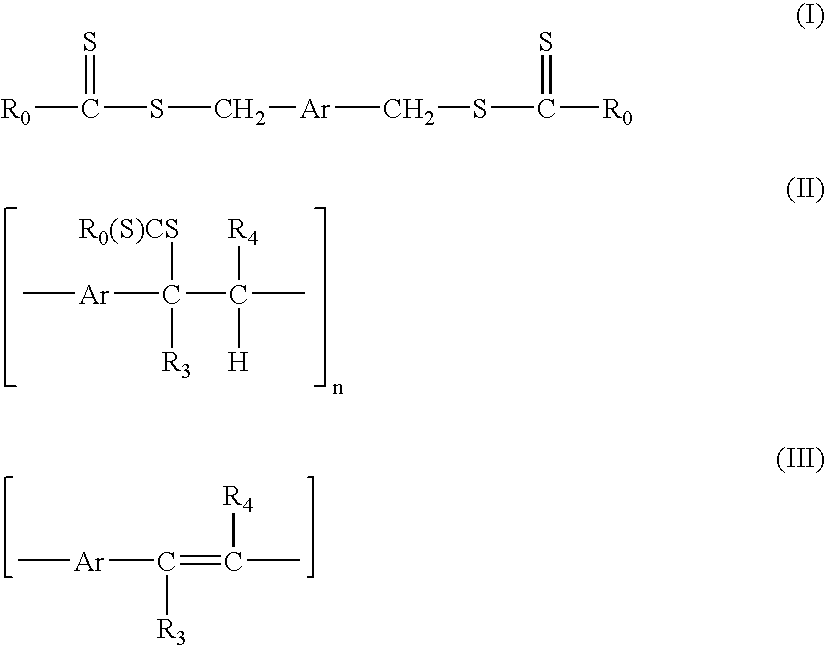Method of preparing derivatives of polyarylene vinylene and method of preparing an electronic device including same
a technology of polyarylene vinylene and derivatives, which is applied in the field of preparing derivatives of polyarylene vinylene and method of preparing an electronic device including same, can solve the problems of incompatibility with device fabrication, inability to manufacture strong acids, and difficulty in polymerization reaction according to wessling method, and achieves low defect level, good quality, and high molecular weight
- Summary
- Abstract
- Description
- Claims
- Application Information
AI Technical Summary
Benefits of technology
Problems solved by technology
Method used
Image
Examples
example 1
[0155] In a first example the synthesis of p-xylylene bis(N,N-diethyl dithiocarbamate) with a formula according to formula (I) wherein Ar=1,4-phenylene, R0═—NR1R2 with R1═R2═C2H5, followed by the polymerisation to the precursor polymer with a formula according to formula (II) wherein Ar=1,4-phenylene, R0═—NR1R2 with R1═R2═C2H5, R3═R4═H and subsequent conversion to the conjugated polymer with a formula according to formula (III) wherein Ar=1,4-phenylene, R3═R4═H is illustrated.
[0156] To 50 ml of an acetonitrile / water solution (5% vol water) of 1,4-bis(tetrahydrothiopheniomethyl)xylene dichloride (6 g, 17.143 mmol), diethyldithiocarbamic acid sodium salt trihydrate (8.87 g, 39.429 mmol) is added as a solid, after which the mixture is stirred at ambient temperature for two hours. Then, water is added and the desired monomer is extracted with ether (3×100 ml) and dried over MgSO4. Evaporation of the solvent yields 6.2 g, which is 90%, of the pure product as a white solid. 1H NMR (CDCl3...
example 2
[0158] In a second example, the synthesis of thiophene-2,5-diylbismethylene N,N-diethyl dithiocarbamate with a formula according to formula (I) wherein Ar=2,5-thienylene and R0═—NR1R2 with R1═R2═C2H5, followed by polymerisation to the precursor polymer with a formula according to formula (II) wherein Ar=2,5-thienylene, R0═—NR1R2 with R1═R2═C2H5 and R3═R4═H, and subsequent conversion to the conjugated polymer with a formula according to formula (III) wherein Ar=2,5-thienylene and R3═R4═H, is illustrated.
[0159] The preparation of the monomer is analogous to that described in example 1, but here a bis-sulphonium salt of formula (IV) where Ar=2,5-thienylene is used. The yield of the reaction is 81%; 1H NMR (CDCl3): 6.84 (s, 2H), 4.69 (s, 4H), 4.01 (q, J=7.2 Hz, 4H), 3.69 (q, J=7.2 Hz, 4H), 1.26 (t, J=7.2 Hz, 12H); 13C NMR (CDCl3): 194.29, 138.76, 126.77, 49.46, 46.70, 36.72, 12.46,11.53; MS (EI, m / e): 258 (M+−SC(S)NEt2), 148 (SC(S)NEt2)
[0160] The polymerisation of thiophene-2,5-diylbi...
example 3
[0172] A third example describes the synthesis of thiophene-2,5-diylbismethylene N,N-diethyl dithiocarbamate-3,4-diphenyl with a formula according to formula (I) wherein Ar=3,4-diphenyl 2,5-thienylene and R0═—NR1R2 with R1═R2═C2H5 followed by polymerisation to the precursor polymer with a formula according to formula (II) wherein Ar=3,4-diphenyl 2,5-thienylene and R3═R4═H.
[0173] For the synthesis of 3,4-Diphenylthiophene, phenylboronic acid (7.12 g, 58.394 mmol), 3,4-dibromothiophene (3.05 g, 12.603 mmol) and KF (2.92 g, 50.345 mmol) are dissolved in a mixture water and toluene 50 / 50 (80 mL). Pd(PPh3)4 (873 mg) is added as a catalyst. After refluxing the mixture for 24 hours, an extraction with CHCl3 (3×50 mL) is performed and the combined organic phases are dried over MgSO4. The crude reaction product is purified by column chromatography (silica, n-hexane). The yield is 75%; 1H NMR (CDCl3): 7.30 (s, 2H), 7.25-7.21 (m, 6H), 7.19-7.16 (m, 4H); MS (EI, m / e): 236 (M+)
[0174] For the s...
PUM
| Property | Measurement | Unit |
|---|---|---|
| temperature | aaaaa | aaaaa |
| temperature | aaaaa | aaaaa |
| temperature | aaaaa | aaaaa |
Abstract
Description
Claims
Application Information
 Login to View More
Login to View More - R&D
- Intellectual Property
- Life Sciences
- Materials
- Tech Scout
- Unparalleled Data Quality
- Higher Quality Content
- 60% Fewer Hallucinations
Browse by: Latest US Patents, China's latest patents, Technical Efficacy Thesaurus, Application Domain, Technology Topic, Popular Technical Reports.
© 2025 PatSnap. All rights reserved.Legal|Privacy policy|Modern Slavery Act Transparency Statement|Sitemap|About US| Contact US: help@patsnap.com



